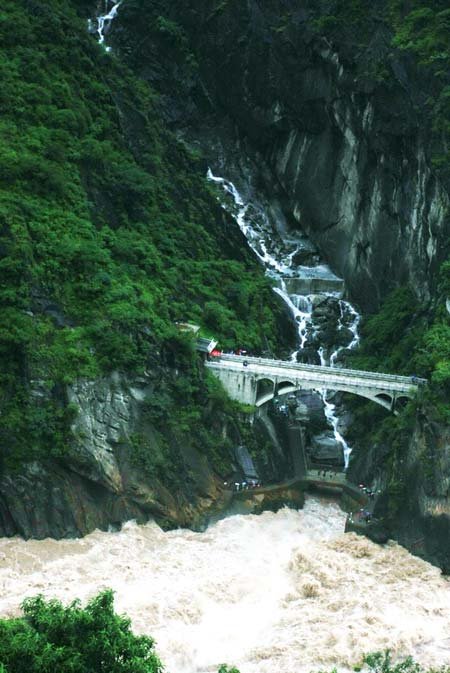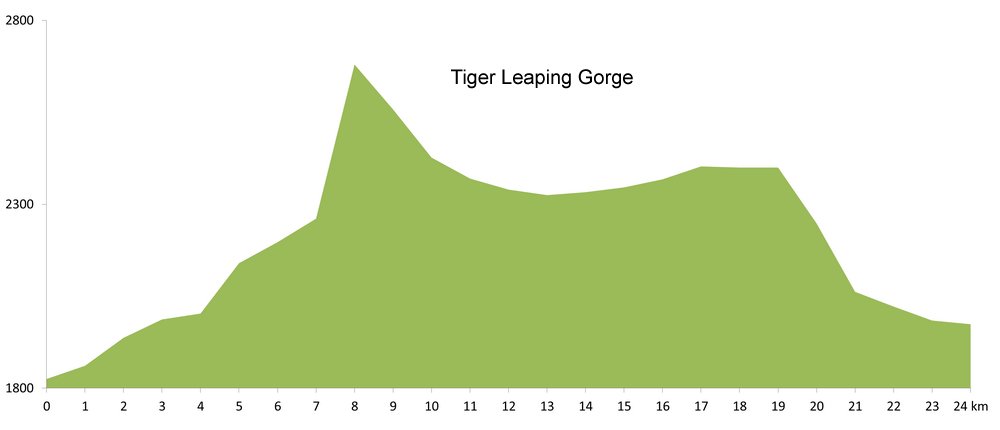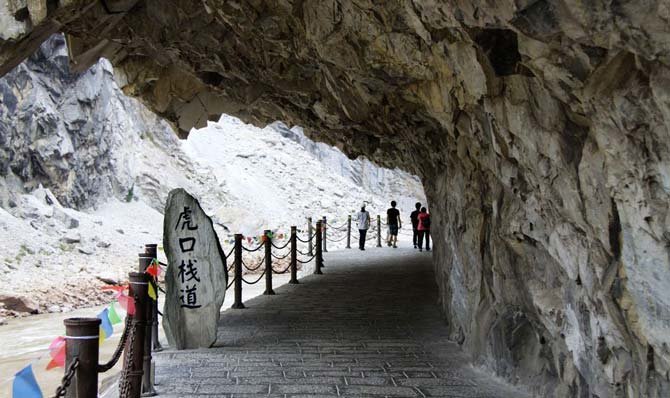
The Tiger Leaping Gorge is a canyon on the Yangtze River – locally called the Jinsha River (River of Golden Sand) – located 60 km north of Lijiang City, Yunnan in southwestern China. It is part of the Three Parallel Rivers of Yunnan Protected Areas World Heritage Site.
Geography

Around 15 km in length, the gorge is located where the river passes between 5596 meter Jade Dragon Snow Mountain and 5396 m Haba Snow Mountain in a series of rapids under steep 2000 metre cliffs. Legend says that in order to escape from a hunter, a tiger jumped across the river at the narrowest point (still 25 metres wide), hence the name.
Administratively, the river in this area forms the border between Yulong Naxi Autonomous County of Lijiang City (southern bank) and Shangri-La County of Diqing Tibetan Autonomous Prefecture (left bank).
Tiger Leaping Gorge is a contender for the world's deepest river canyon, depending on the exact definition used. The inhabitants of the gorge are primarily the indigenous Naxi people, who live in a handful of small hamlets. Their primary subsistence comes from grain production and tourists. The gorge is not considered navigable. In the early 1980s, four rafters attempted to go down the gorge and were never seen again. In 1986, the first known successful attempt to sail through the gorge was made by the first expedition to float down the entire length of the Yangtze, starting at the river's high source at the Gelandandong glacier lake.

The area was officially opened to foreign tourists in 1993, but had attracted adventurous backpackers already in the 1980s. Officials plan to improve the existing trails and roads, bringing tour buses and more development. These plans arouse highly varied reactions among the local population, from strong opposition to strong support.
Natural crystals are mined from areas in and surrounding the Tiger Leaping Gorge.
Roads and Trails

Hiking the length of the gorge is possible. The hiking path (the high road) is well-maintained and marked, although sometimes narrow, and is used by the Naxi as part of everyday life. This trail is longer than the lower road, approximately 24 kilometres, but more varied. It features a variety of micro-ecosystems, waterfalls, and a fair number of guesthouses for trekkers. These guesthouses are not well heated, which combined with the unpredictable nature of high mountain weather makes this trek unadvisable during the rainy season, although in recent years the raining periods got shorter and it got possible to hike there again.

The lower road, stretching about 15 kilometers from Qiaotou through the Gorge, is a new stretch of pavement (until recently a simple mule track) crossed by several waterfalls, and frequently beset by rockslides. Some portions of the road have been known to disappear into the river below. The road follows the Yangtze, so there are more views of the river, and a stronger sense of being in a gorge than on the upper trail. Where the high road descends to meet the lower road, one can climb down to the river near the Tiger Leaping Stone, the point at which the tiger is said to have leaped. In July 2010, the Chinese government closed the gorge to visitors because a new lower road was being built. It was reopened again and the gorge is fully hikable and drivable. Current entry fee is 65 RMB per person.
Environmental Destruction
Although Tiger Leaping Gorge is an essential part of the World Heritage protected Three Parallel Rivers of Yunnan, the Chinese government has floated proposals for a hydroelectric dam on the Jinsha River since 2004. However, in 2007, the Yunnan provincial government scrapped this project.
Details of the scrapped project follow: Construction has already begun on the other 12 dams of the same project which lie just outside the boundaries of the heritage area, even though it has not been approved by the State Council. Media reports suggested that the Lijiang city government is waiving standard procedures in order to facilitate the project.

The project would displace up to 100,000 people to the north, mainly the Naxi minority, to a Tibetan area with harsh climate and the staples are such unfamiliar crops as barley and potatoes; virtually stop the flow of the upper Yangtze River, and irreparably alter the landscape of the Tiger Leaping Gorge. The project was abandoned in Dec 2007. This project was also related to the Three Gorges Dam and the South-North Water Transfer Project, which would cause massive environmental damage and the destruction of thousands of cultural sites. (wikipedia)
- 1614 reads
